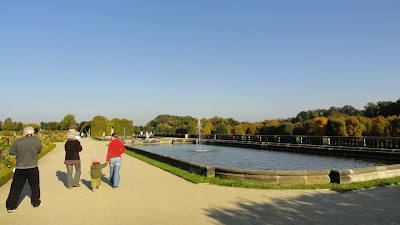"Saxony" sounds strong, rich, luxurious and is fun to say.
Heinrich I was the first Saxon ruler to be King of Germany (919-936), establishing the art-loving House of Wettin which ruled for more than 800 years. Augustus the Strong (1694-1733) was its star.
Martin Luther's Reformation began its spread from Wittenberg in 1517.
Saxons were builders of palaces and collectors of art. There are 240 museums in Saxony, Germany's densest population of them.
Here are the former residences I hit on a one-day tour organized by the German Tourist Board. Alas, though well-organized, it was timed to the minute with no room for seeing everything much less lingering.
Mortizburg Castle, originally built by Duke Moritz as a hunting lodge in 1723, was turned into a grand venue for parties by Augustus the Strong. It is a moated (in a pond which in Germany means it was man made; a lake is nature's product), four towered Baroque jewel of rich golden ocher trimmed in white and capped by an orange roof.
Known primarily for its collection of antlers (the best in Europe), leather wall hangings and and feather artwork, I found the kitchen implements, menus for lavish royal parties and the peaceful vistas of primary interest.
Didn't have an opportunity to visit the famed Moritzburg stud whose warm-blooded horses are coveted by many an equestrian (Queen Elizabeth bought 14 Mortitzburg stallions).
Tip: You will park nearby and walk to the castle along a bridge. The downstairs is easy, but you'll encounter steps on the tour of upstairs.
If Moritzburg is a jewel, Pillnitz Castle and Park is a chinoise crown of gems, a waterfront pleasure palace. With its pagoda-style roofs, Castle Museum, Museum for Crafts and Arts, English, Dutch and Chinese gardens, you don't know where to look or go first.
Tip: Take a day to pace yourself and do it justice. You will walk a lot but you won't be overwhelmed by stairs. There are places to eat and drink and vendors offer some of Saxony's special treats - gingerbread filled with marmalade and covered in chocolate. It wasn't my fave but do try some.
To Augustus the Strong, the Orient was heaven on earth, thus the chinoise style. He also considered the Elbe River to be Saxony's Grand Canal so Pillnitz sits 250-feet above the river.
Warning: Everyone says arriving at Pillnitz via the Elbe the way royalty once did is the best way. It probably is if you aren't a Leveler; a 250-foot rise in elevation requires a lot of steps. I'd advise coming by road and saving your energy.
The gardens are superb. You won't want to miss the 140-year-old red beech, the 250-year-old Japanese camellia tree which produces 35,000 blossoms in March and April or a remarkable 150-year-old lilac tree, an ordinary German variety on the bottom, Chinese lilac on the top. It blooms in May. Gardeners have been trying to reproduce the combination for years without success.
Perhaps they should stop trying so hard. The secret of producing porcelain was discovered in Saxony by accident. Johann Friedrich Bottger, an apothecary and charlatan, claimed he could make gold, but what he did was succeed in firing porcelain instead. After eight years he presented Augustus the Strong with porcelain, soon dubbed "white gold," which was almost as good. For years, Europeans had tried to recreate this prized product of the Orient and in January 1710, Augustus proclaimed he had. To keep Bottger and the secret safe from poaching monarchs, he ordered a factory to be built in Albrechtburg Castle high above Meissen where it operated for 153 years.
 The Baroque Garden Grossedlitz is an unfinished vision of Augustus the Strong and supposedly the the best pure Baroque garden around. Meant to be the Versailles of Saxony, it presents quite the vistas and will no doubt be worth a visit to lovers of formal gardens. I found it exhausting and not worth it because of the many different levels and stairs leading to and from them. The map shows a "barrier free path" to the lower areas but I never saw it.
The Baroque Garden Grossedlitz is an unfinished vision of Augustus the Strong and supposedly the the best pure Baroque garden around. Meant to be the Versailles of Saxony, it presents quite the vistas and will no doubt be worth a visit to lovers of formal gardens. I found it exhausting and not worth it because of the many different levels and stairs leading to and from them. The map shows a "barrier free path" to the lower areas but I never saw it.Blame it on too many palatial residences in one day. German efficiency is grand but some of us need more American ambling and idling.
Tip: You can buy a Tour Pass for seven days that will get you into more than 50 of Saxony's historic castles, palaces and gardens for 18 euro.
By the way, I found residents, guides and the average herr in the street, willing to talk about World War II, the damage - human and otherwise - incurred, living in the Communist-controlled zones and the reactions when the wall fell and reunification arrived. Such conversations invariably begin when the guide or resident explains the damage from Ally bombing and subsequent reconstruction, pointing out that dark stones are original, pale stones are replacements.
Next posts: Saxony's signature cities, Dresden then Leipzig.
Note: To see what what was served to Augustus the Strong go to my blog, www.foodafar.blogspot.com.












0 comments:
Post a Comment